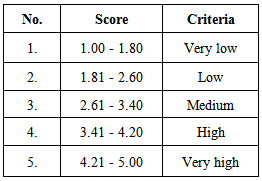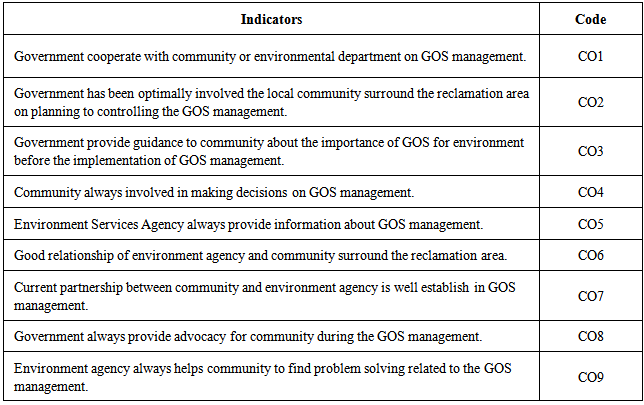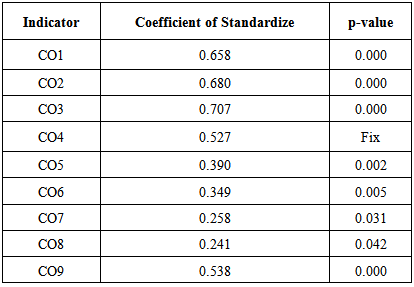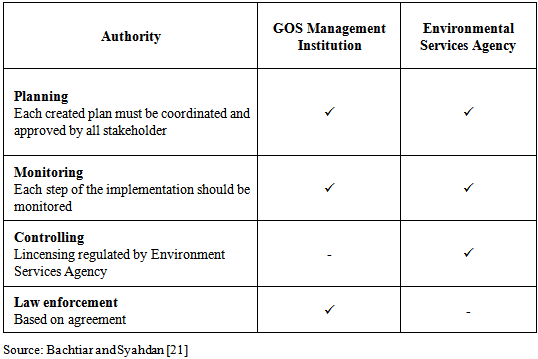-
Paper Information
- Previous Paper
- Paper Submission
-
Journal Information
- About This Journal
- Editorial Board
- Current Issue
- Archive
- Author Guidelines
- Contact Us
International Journal of Ecosystem
p-ISSN: 2165-8889 e-ISSN: 2165-8919
2014; 4(6): 246-250
doi:10.5923/j.ije.20140406.02
Effective Co-Management Model on the Green Open Space Management in Reclamation Area of Manado Beach
Sonny Wantouw1, Antariksa2, Bagyo Yanuwiadi3, Zetly Tamod4
1Doctoral Program of Environment Science and Technology, University of Brawijaya
2Department of Architecture Engineering, Faculty of Engineering, University of Brawijaya
3Department of Biology, Faculty of Mathematic and Natural Science, University of Brawijaya
4Department of Soil Sciences, Faculty of Agriculture, University of Sam Ratulangi
Correspondence to: Sonny Wantouw, Doctoral Program of Environment Science and Technology, University of Brawijaya.
| Email: |  |
Copyright © 2014 Scientific & Academic Publishing. All Rights Reserved.
The beach reclamation in the City of Manado, Indonesia was developed as functional area with super block pattern and lead to the formation of Central Business District (CBD) BAM. The CBD affected the change on the city’s coastal area. It reduce the accessibility to the Green Open Space (GOS), unsustainable function of GOS, inflexibility access arrangement of GOS to the community, and the emergence of dominant public area which tend to be an enclosed and private-domain. Thus caused the disconnection of social interaction. This study aimed to assess the correlation of GOS activity on Manado coastal area toward public perception and participation in reclamation area of Manado Beach. We used proportional random sampling by questionnaire. The sample size was adjusted to the estimation and interpretation of Structural Equation Modeling (SEM) analysis. Total of 100 respondents consisted of government, businessman, and the society in the land conversion area. The result strongly emphasized the implementation of guidance by government to the community about the importance of GOS management.
Keywords: Co-management, Green Open Space (GOS), Reclamation, Structural Equation Modelling (SEM)
Cite this paper: Sonny Wantouw, Antariksa, Bagyo Yanuwiadi, Zetly Tamod, Effective Co-Management Model on the Green Open Space Management in Reclamation Area of Manado Beach, International Journal of Ecosystem, Vol. 4 No. 6, 2014, pp. 246-250. doi: 10.5923/j.ije.20140406.02.
Article Outline
1. Introduction
- City is probably the most complex expression of human life [1]. Generally, city aspects were consisted of space as a physical form with its elements; and human as a user and subject of city development [2]. City also become the central of various activities such as social, economic, political, cultural and administrative activities [3]. It has a propensity to be grown larger with the support of the surrounding region. The city development provide consequences on spatial issue such as increased demand on space to accommodate the need of facilities and infra-structure [4]. Public space is functioned area for activities related to community interaction, increased revenue and arts performances [5]. Attractive public spaces will be visited by people with various levels of social life, economy, ethnic, education, age and different interest [5]. In general, Green Open Space (GOS) is a part of the public open spaces filled by plants, both endemic or intoduction [6]. Its provision has many benefit in ecological, psychological, socio-cultural and architectural aspect that provide economic benefits or welfare for the community [7]. Green Open Space offer opportunity to build social interaction and contribute to enhance sense of place, thus increasing the community's identity, solidarity, security and improve the comfort of society [8, 9]. Green Open Space as an attractive public space visited by the public [5]. This shows that GOS become a public asset that provide many advantage for various range of community’s background and interests.Ironically, the higher development of open space in urban area affect the land use change and consequently lead to decreased allocation for GOS, which below 30%. Therefore, stakeholders and all elements of society need to increase their participation in improving the procurement of green space area [10]. Well functioned GOS on urban system needed a comprehensive management from various stakeholder groups such as government, private sector and community.Co-management approaches or collaborative management, also known as shared-management, multi-stakeholder management, round-table agreement and community-based management. This approach is management system that accommodates the interests of all stakeholder by cooperation mechanism. Emphasis of this concept is the recognition of complex natural ecosystems and requires approaches that go beyond command and control strategies to encompass flexible governance solutions [11]. This management is encouraged by correct recognition of each stakeholder to achieve a common goal, thus probability of all stakeholder participate on share authority, responsibility and profit in the management process are broad [12]. The paradigm is growing rapidly in natural resources management where GOS as conservation area which need a joint (partnership) management between government, communities and stakeholders. Therefore it is also called participatory management [13].Manado is a city in Indonesia that possessed wide coastal area with all activity and social dynamics of the citizen’s settlement. This condition is accompanied by development growth causing centralized community activities, both for beach tourism or utilizing informal sector for economic aspects. These activities affect the public space in coastal areas, which lead to the development of reclamation area; indicate loss of public space [14].Reclamation on Manado beach developed functional area with super block pattern and formed the Central Business Distric (CBD) BAM, which changed the coastal area. This condition has a risk of erosion and changes of coastal line, and threaten the human settlement in coastal areas. Impact of reclamation on coastal area into buildings reduce the accessibility of GOS, GOS function become unsustainable, no flexibility access for the community to GOS, and domination of public area which implied enclosed and private-domain that influence the disconnection of social interaction. This condition also degraded GOS social function in forming social interaction, which particularly required for creating social activity and reality. This social reality is based on individual motivation and their social actions [15].The issues above encourage us to assess the GOS management model in the coastal area of Manado by co-management approach. This approach is a potential alter-native method to improve the weakness of state-based approach and community-based on GOS management in the coastal area. It is due to co-management approach that based on aliance and partnership that convinced as proper method to sustainable development. The purpose of this study is to assess the formation of alternative co-management models on GOS management comprehensive-ly, therefore the enviroment quality of surround society can be maintained and the existence of GOS can be enhanced.
2. Research Method
2.1. Study Site
- This studies conducted in four District within the center of Manado, i.e. Wenang, Sario, Malayang and Tuminting (Fig. 1). Manado is located in North Sulawesi, with total area of 157.26 km2. The population of Manado city is dominated by productive age, which consisted of more women than man. The education level of the workers is mostly high school graduates by 46.4%, and qualified diploma/ university of 17.8%. Their preference of work complied in three main sectors, i.e. services (tertiary) of 78.9%, manufacturing of 16.6%, and agriculture of 4.5%.
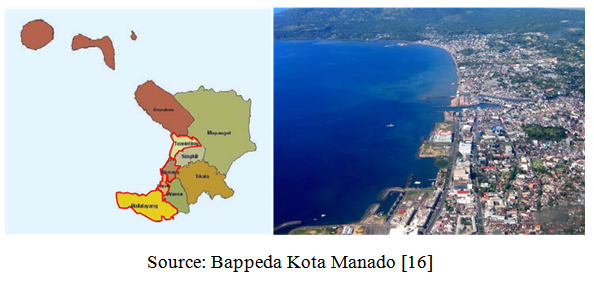 | Figure 1. Administration map of Manado |
2.2. Data Collection
- Quantitative data were sampled by proportional random sampling method using questionnaires. Interpretation criteria of answer scores were classified into five levels (Table 1). The sample size was adjusted based on estimation and interpretation of Structural Equation Modeling (SEM) analysis refers to Ferdinand [17]. This studies used a hundred respondents, which consisted of government, employers and land conversion affected community. We also asked their knowledge and opinion on the reclamation issue of Manado Coastal Area.
|
2.3. Data Analysis
- Analysis of effective co-management model on GOS in reclamation area of Manado beach was using Structural Equation Modeling (SEM). This analysis allows the testing of multiple dependent variables and multiple independent variables simultaneously [17]. Variable of co-management consisted of nine indicators (Table 2). Data analysis procedures followed the steps of structural equation modeling [18]: testing of each variable and selection of input matrices and estimation models. The indicators which formed the co-management model on GOS management in reclamation area described the frequency distribution of respondents' answers toward the co-management models.
|
3. Results
3.1. Co-Management Indicator on GOS Management
- The results showed eight indicators classified in the high category, except for CO8 in medium category (Fig. 2). The highest indicator is CO3 (3.84), that government provide guidance to community about the importance of GOS for environment before implementation of GOS management. It is implied that respondents received guidance from government concerning the matter of GOS management.
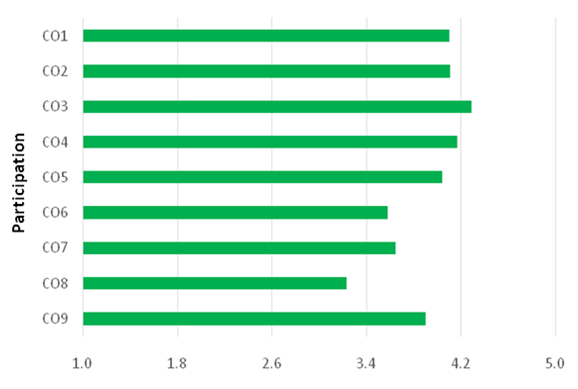 | Figure 2. Average score of co-management indicator |
3.2. Co-Management Model on GOS Management
- The results showed that all indicator had positive standardize coefficient or loading factor and p-value less than 0.05 (Table 3). The p-value indicates that all indicator were significant in measuring variable of co-management. Besides that, the positive standardize coefficient or loading factor showed that the higher respond would influence on the higher value of co-management variable. The highest coefficient standardize shown by the third indicator (CO3). It implied that CO3 indicator was the strongest indicator in measuring co-management variable. This result shows the crucial role of guidance on GOS management from government before the implementation.
|
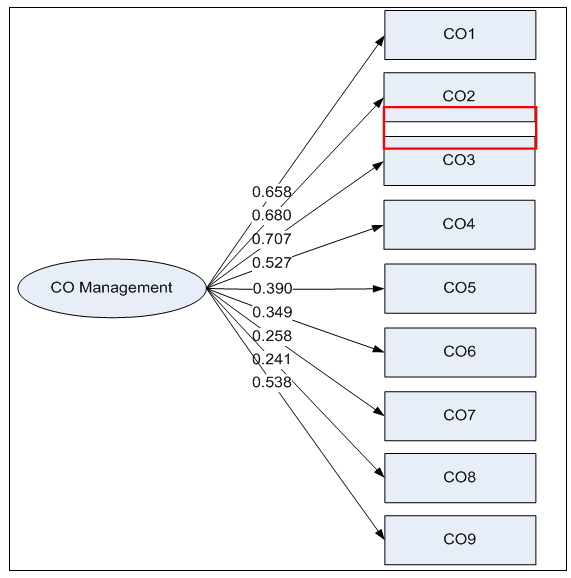 | Figure 3. Model of co-management variable |
3.3. Perception of Local Community on the Reclamation
- Most respondent were objected to the reclamation of coastal area in Manado, although they admitted to get economic benefit from the reclamation activities, as stated also by Wagiu [19]. However, they biggest concern is on the coastal ecosystem issue that occurred due to the damage from the reclamation activities. At the end of the inquiry, respondents emphasize that they are troubled by the reclamation program on the coastal area of Manado.
3.4. Environmental Impact of the Coastal Reclamation
- Types of environment impact that constantly threaten the sustainability of the coastal areas are as follows: increasing air temperature, bad or obstructed air circulation due to the buildings, declining quantity of open space, damaged coastal ecosystems, traffic congestion, increased CO2, decreased O2. Thus surround community in coastal areas feel uncomfortable.In addition Poli et al. [20] explained that the impacts of the construction are the sedimentation and accumulated garbage in the coast; result the changes in the behavior of ocean currents. These events lead to the risk of erosion and shoreline change and threatening the safety of the coastal area settlements [19]. The threat of global warming also hit the coastal areas of Manado which must face the risk of rising sea levels over time.
4. Discussion
- Law No. 32 of 2004 on Regional Government [21] mentions that the local government has the authority to manage natural resources. Based on previous policy, natural resource management which centralized on government often risk to failure. Thus it is necessary to cooperate with the community to create a partnership or participatory management. Based on the results, government had important roles on community guidance before the implementation of GOS management. Government refer the ISO 14001 standard in deliver the guidance. This document provide guidelines and checklist for government and community during the implementation of GOS management [22]. However, these guidelines may require modifications depending on the environmental conditions of the study area. The co-management model is still relatively new system, thus needs more assessment about the positive and negative impacts of the implementation. Therefore, the government requires the collaboration from representative and recognized institution from the community. This new GOS management institution represents all related stakeholder. The establishment of this management institutions should be based on management area instead of the administrative boundaries of district government. After the establishment, the local government were expected to create forms of cooperation with the management institution. This partnership is limited GOS management. The local government represented by Environmental Services Agency while provincial government represented by BAPEDALDA Province. Table 4 described the authority given to each management institution.
|
5. Conclusions
- In the preparation of GOS co-management model on reclamation area of Manado, there are nine co-management indicators that need to be applied. However, we strongly emphasized the implementation of guidance by government to the community about the importance of GOS manage-ment. Community awareness on the environmental issue towards the reclamation of the coastal area of Manado is needs to be developed in line with the government program.
 Abstract
Abstract Reference
Reference Full-Text PDF
Full-Text PDF Full-text HTML
Full-text HTML